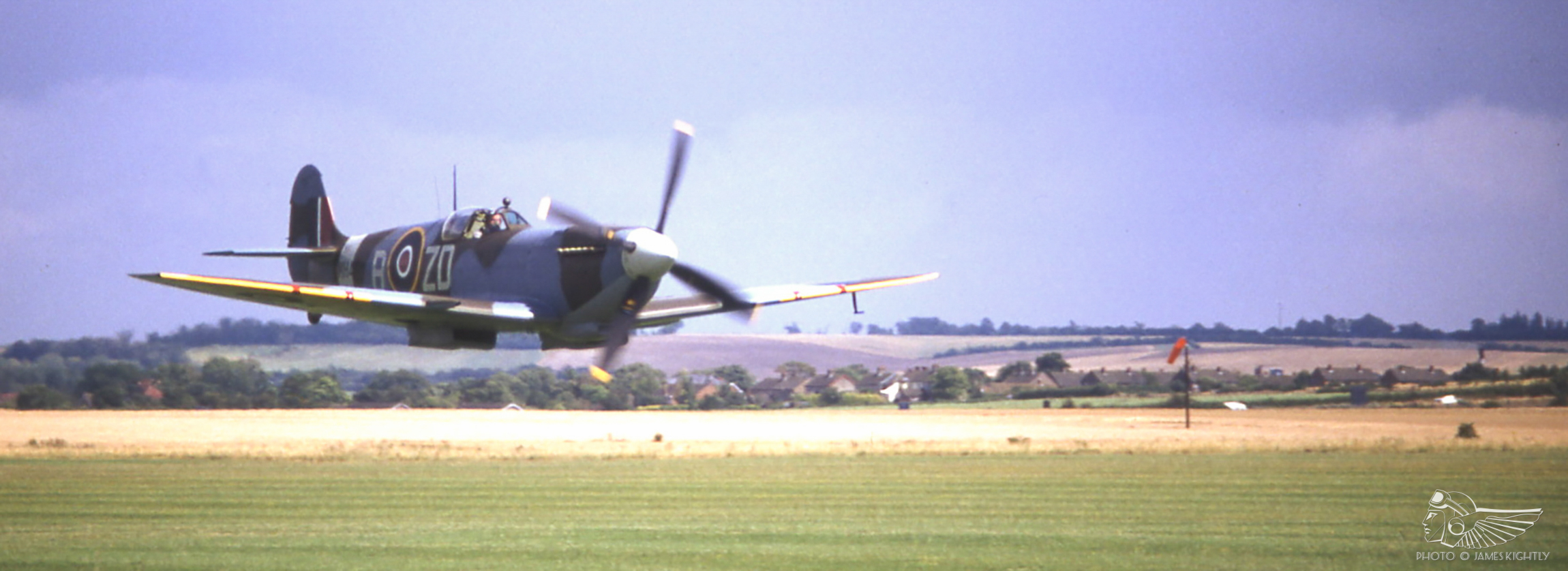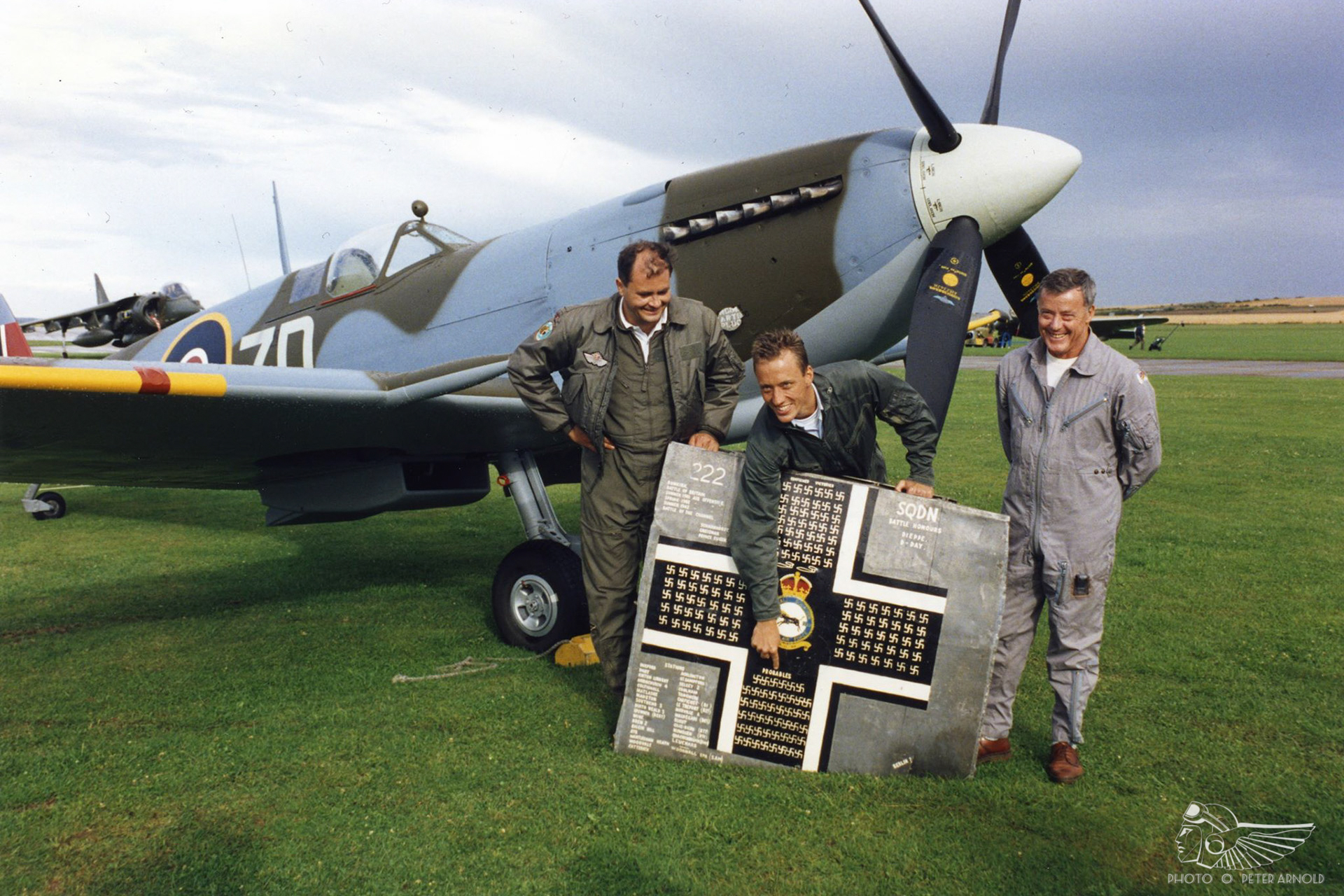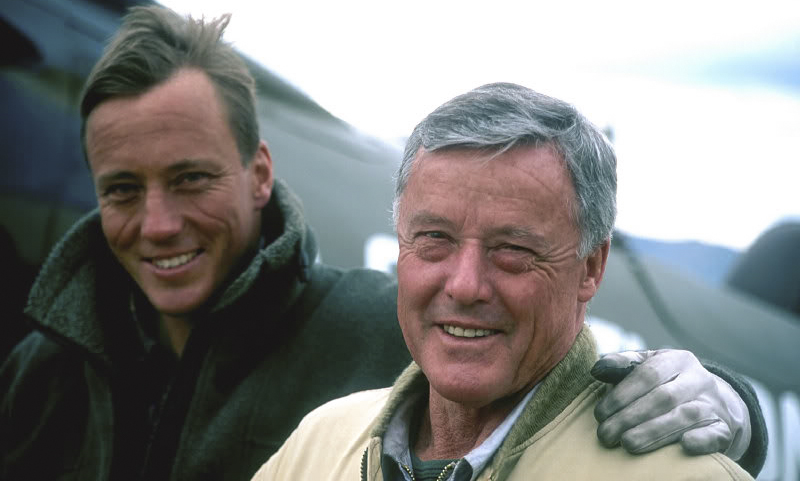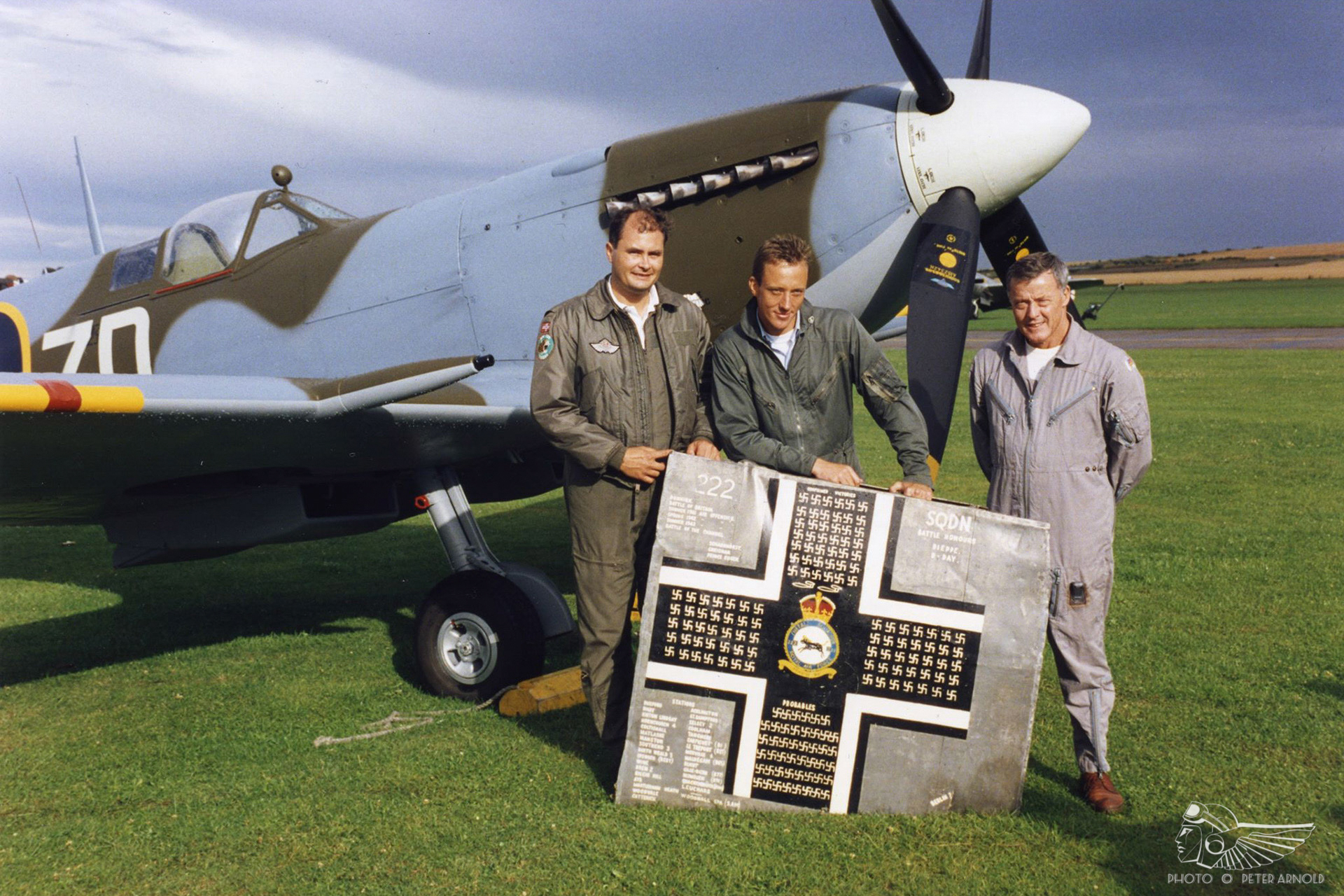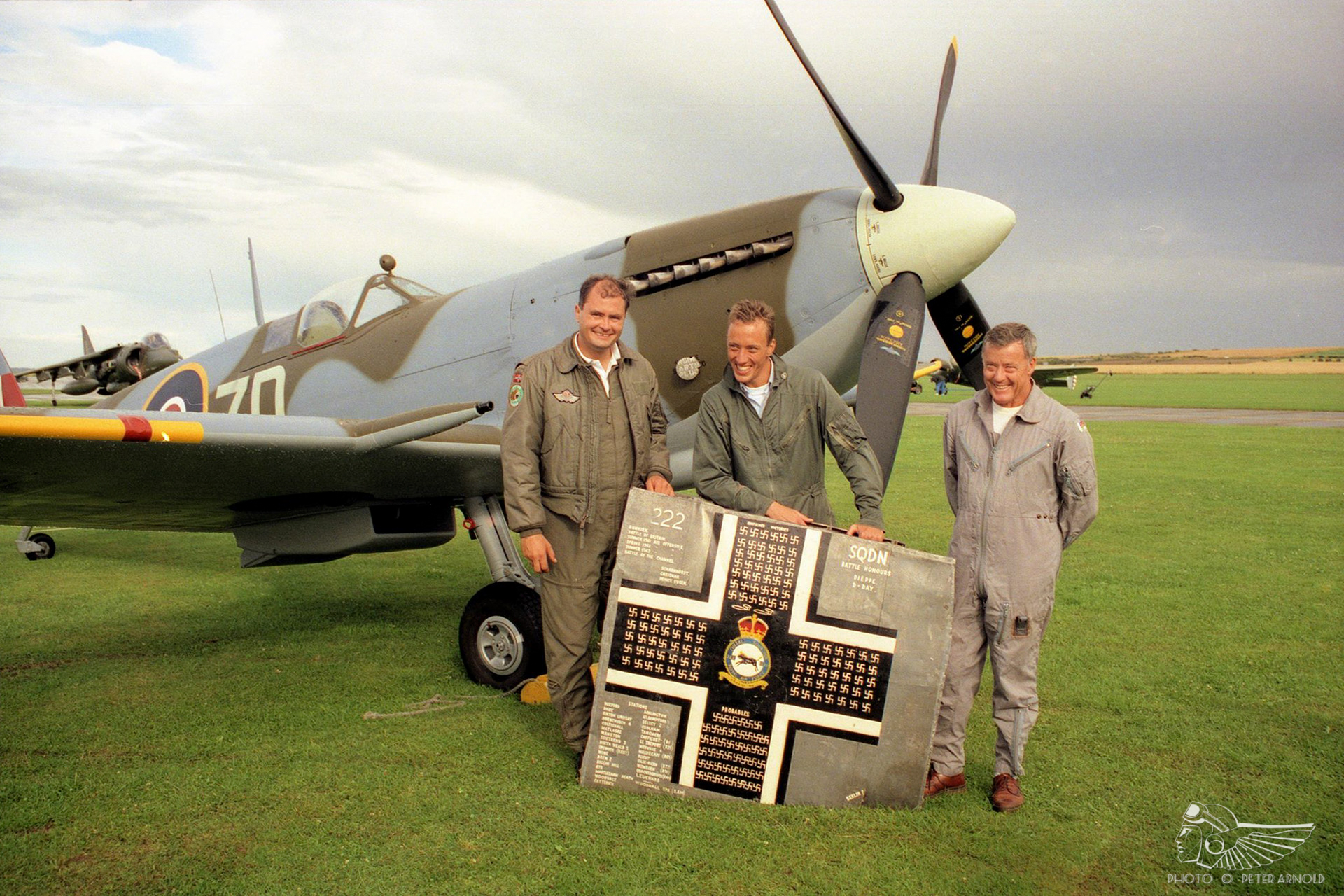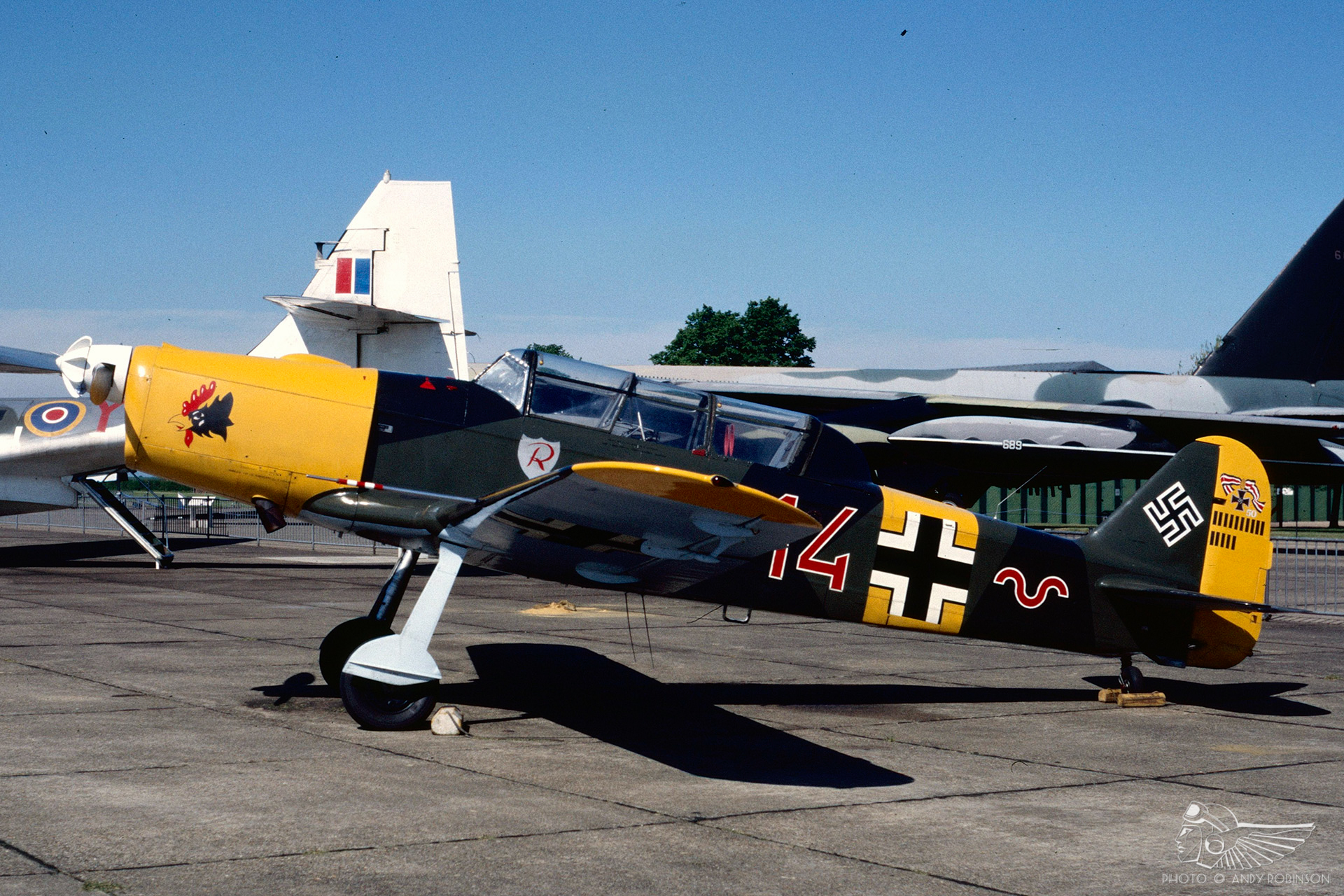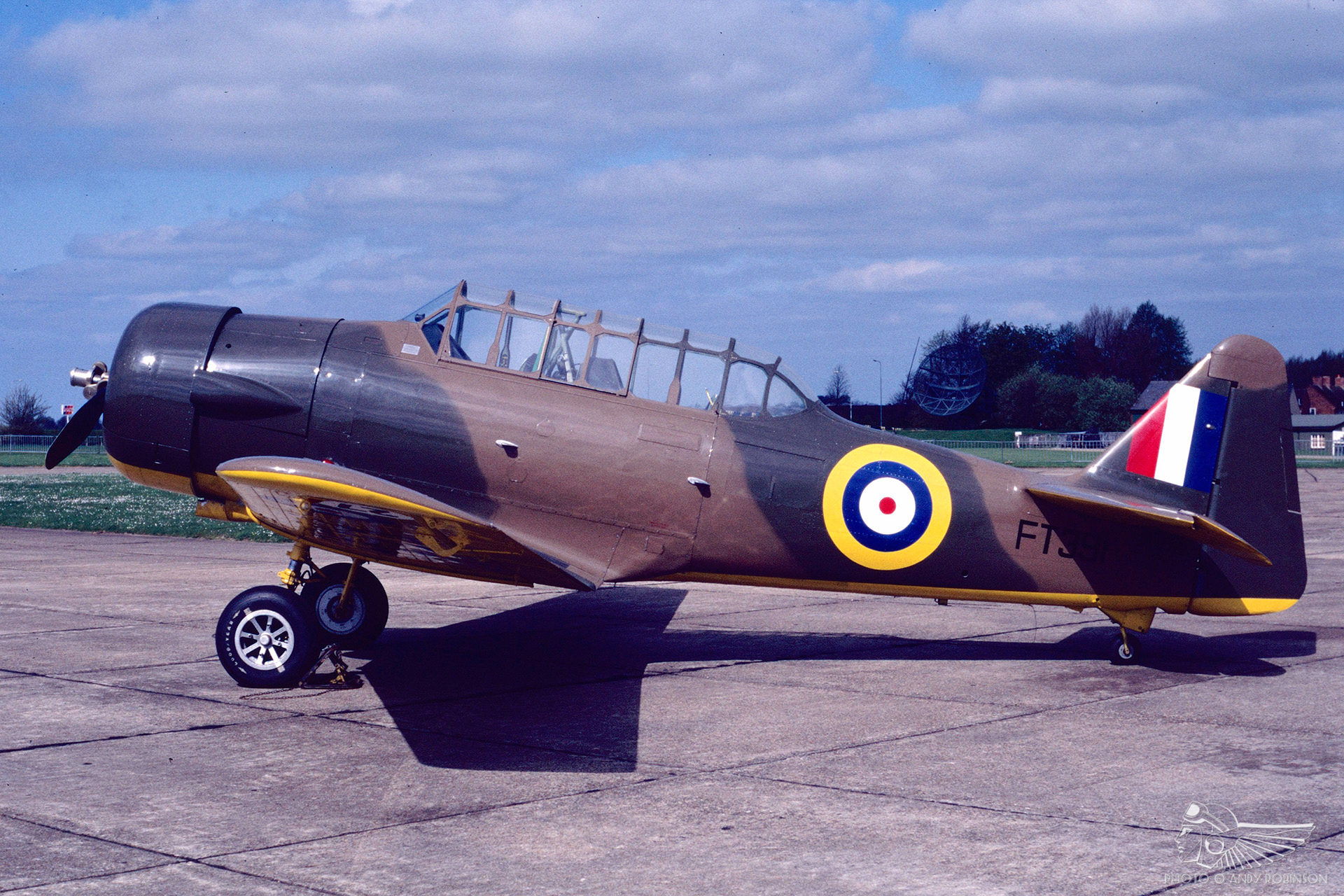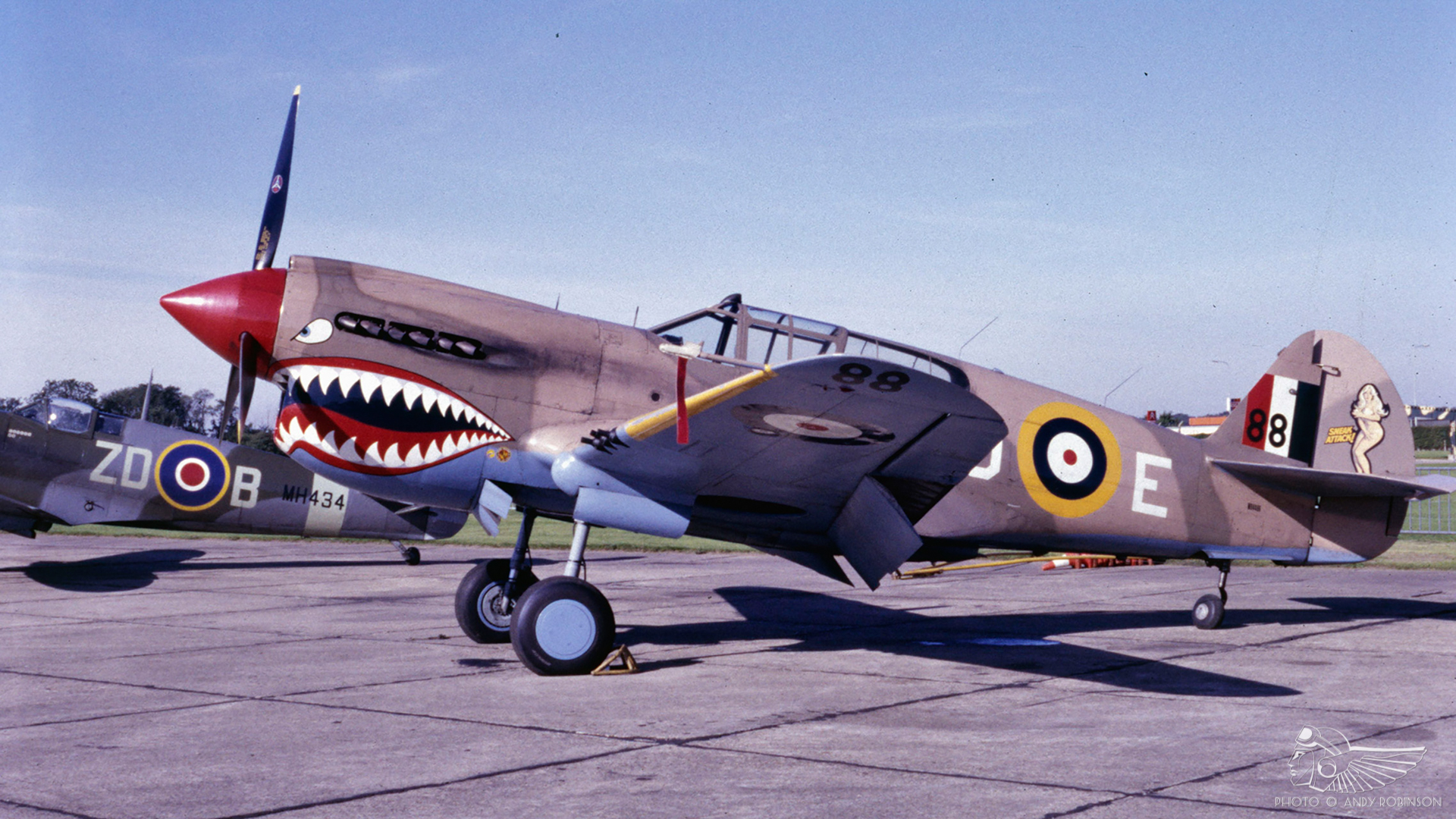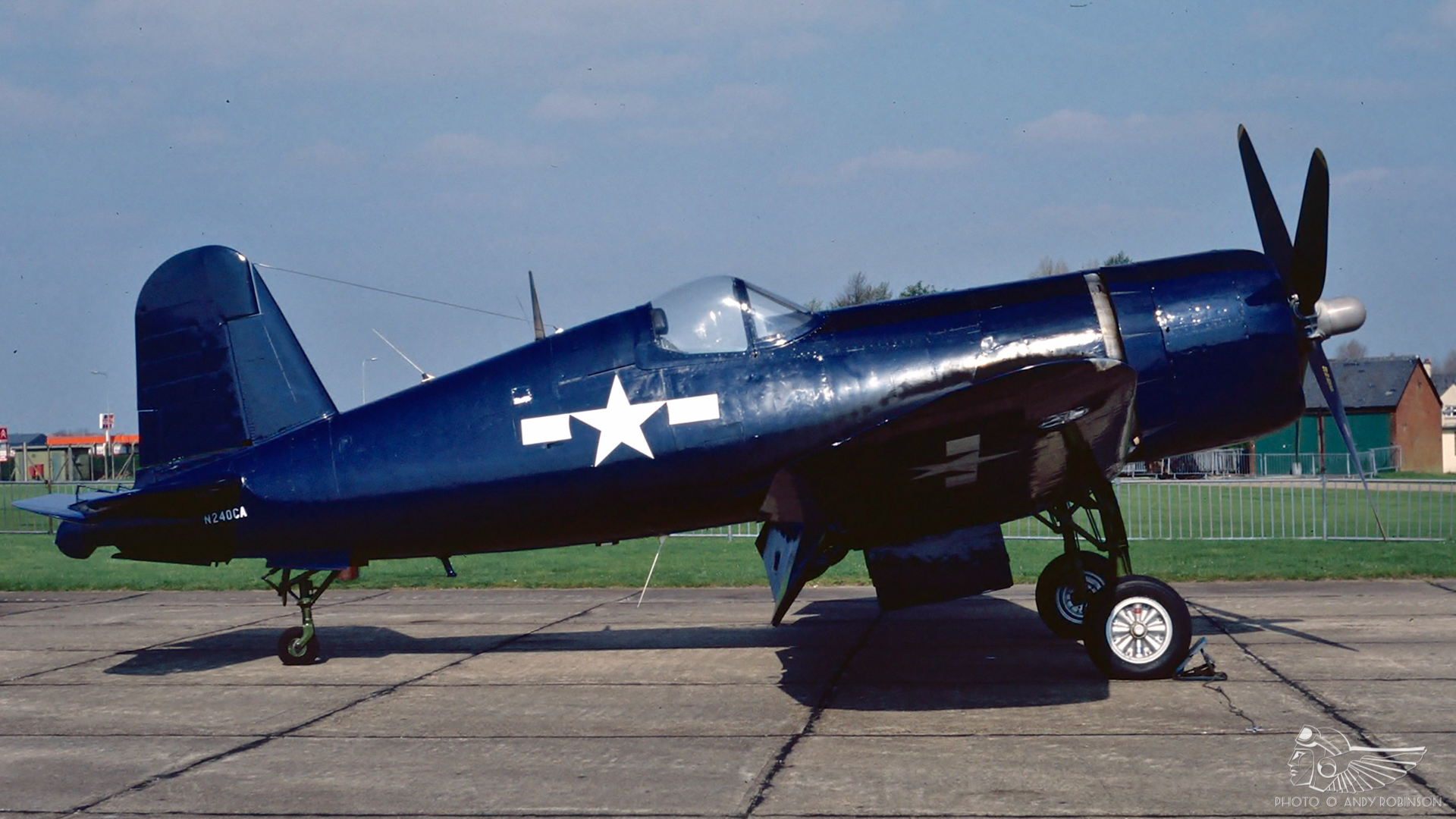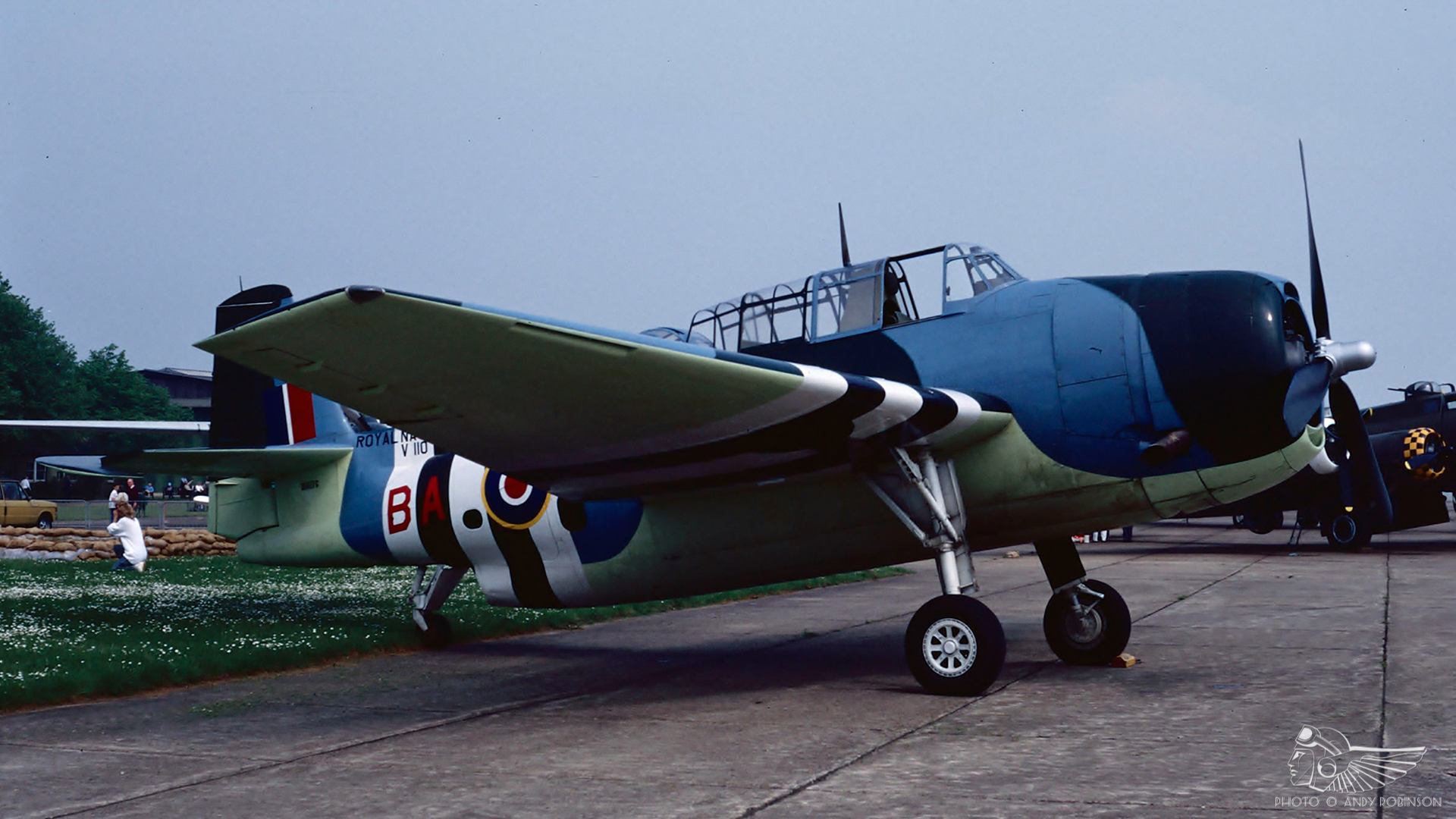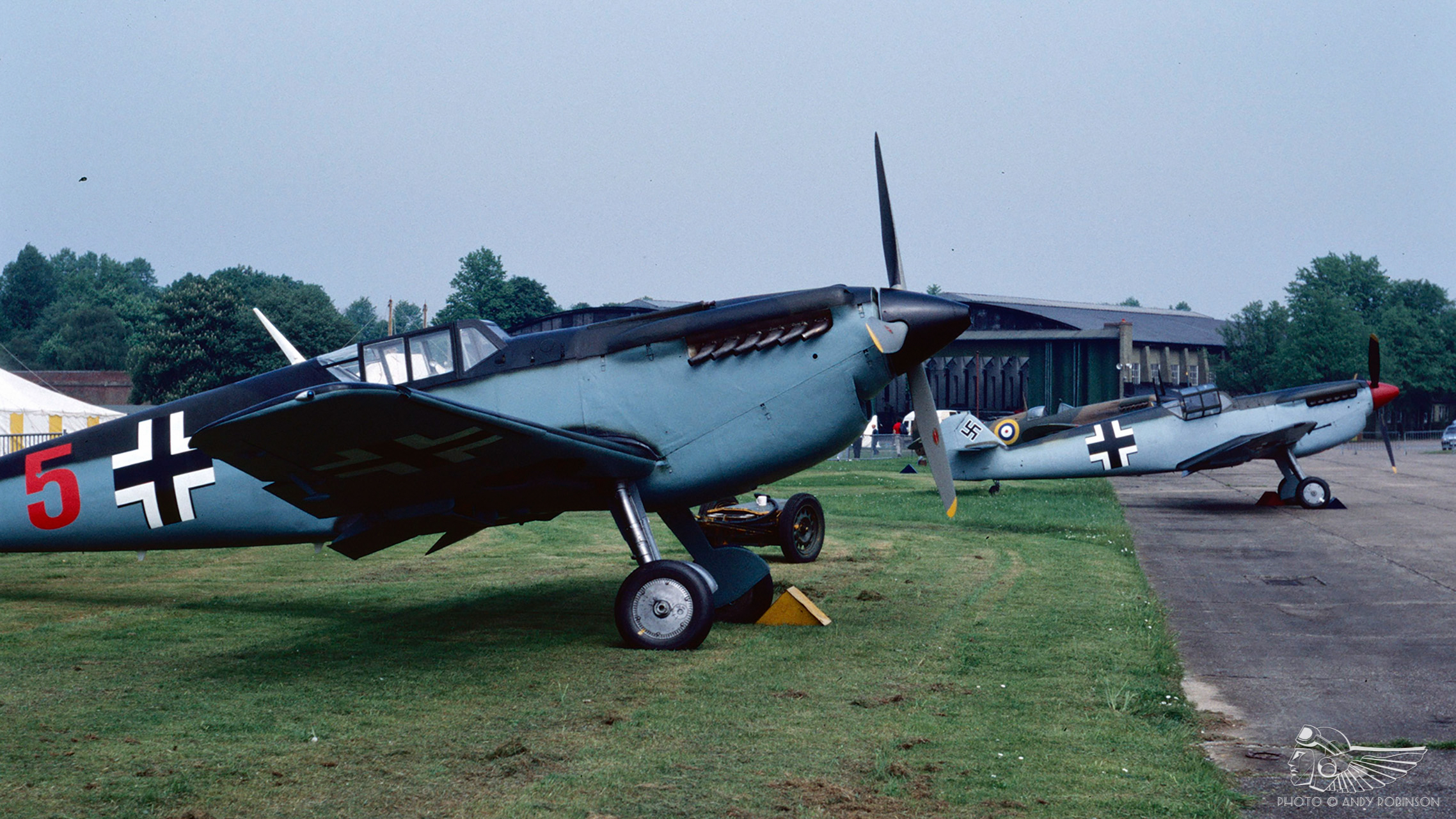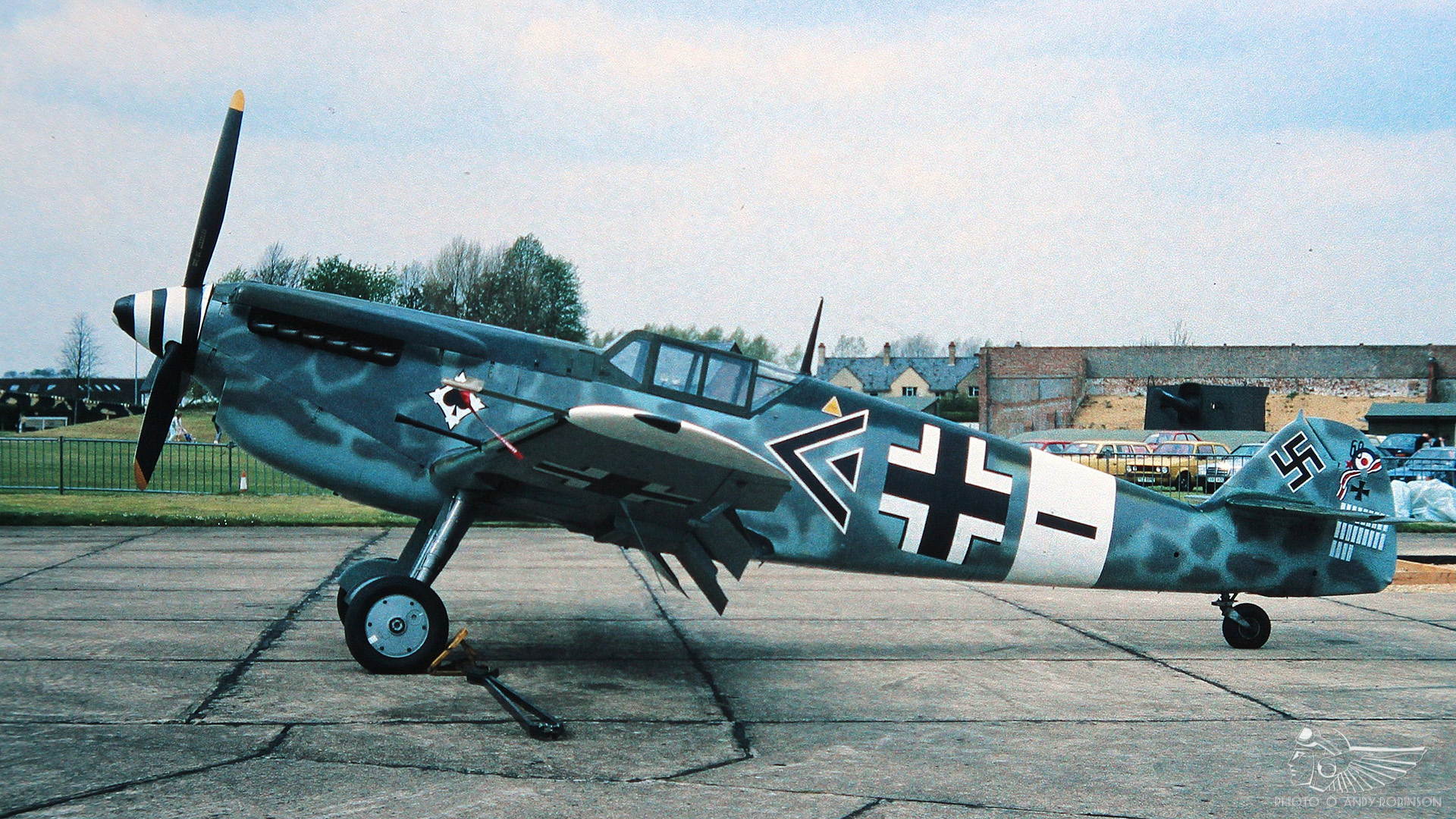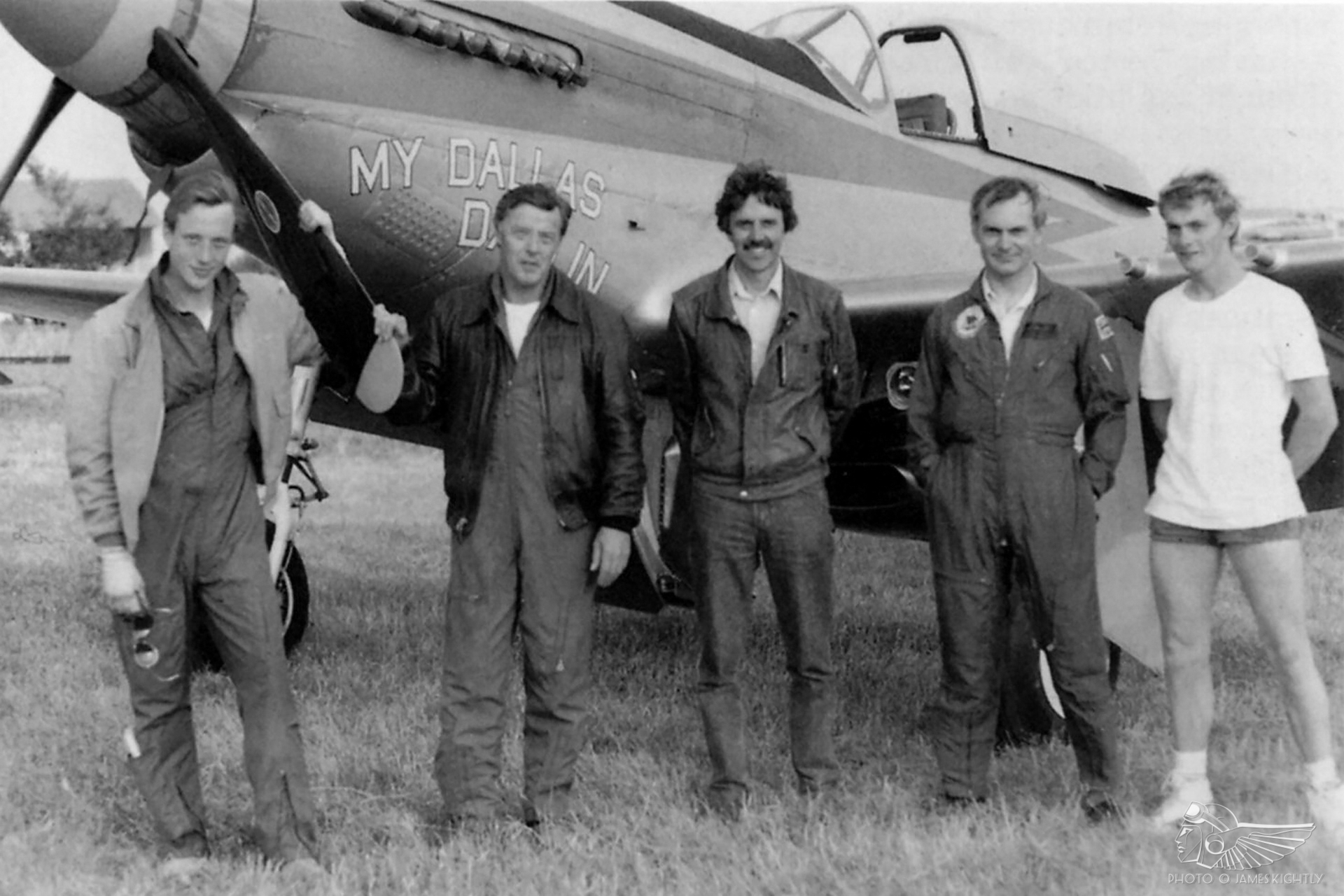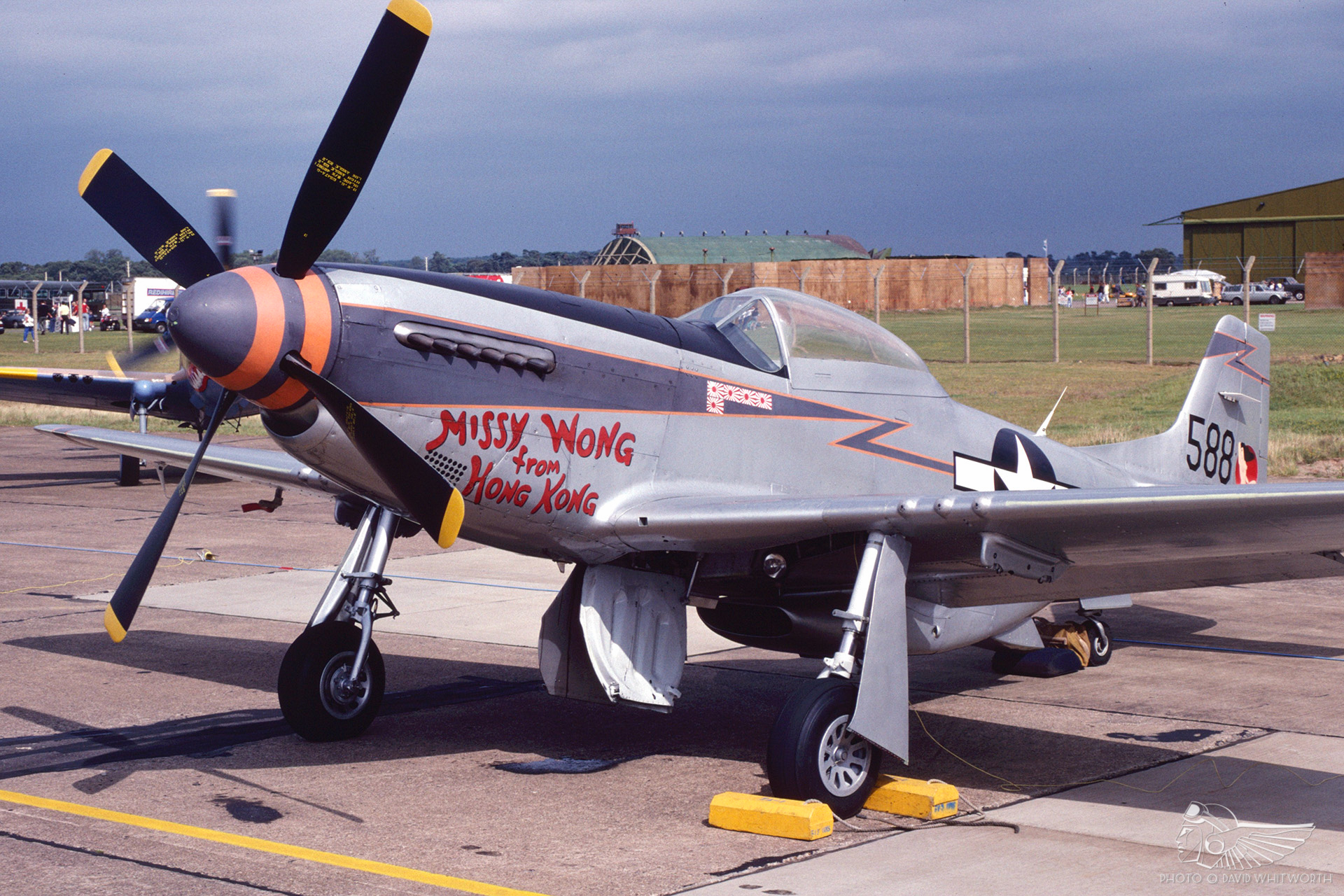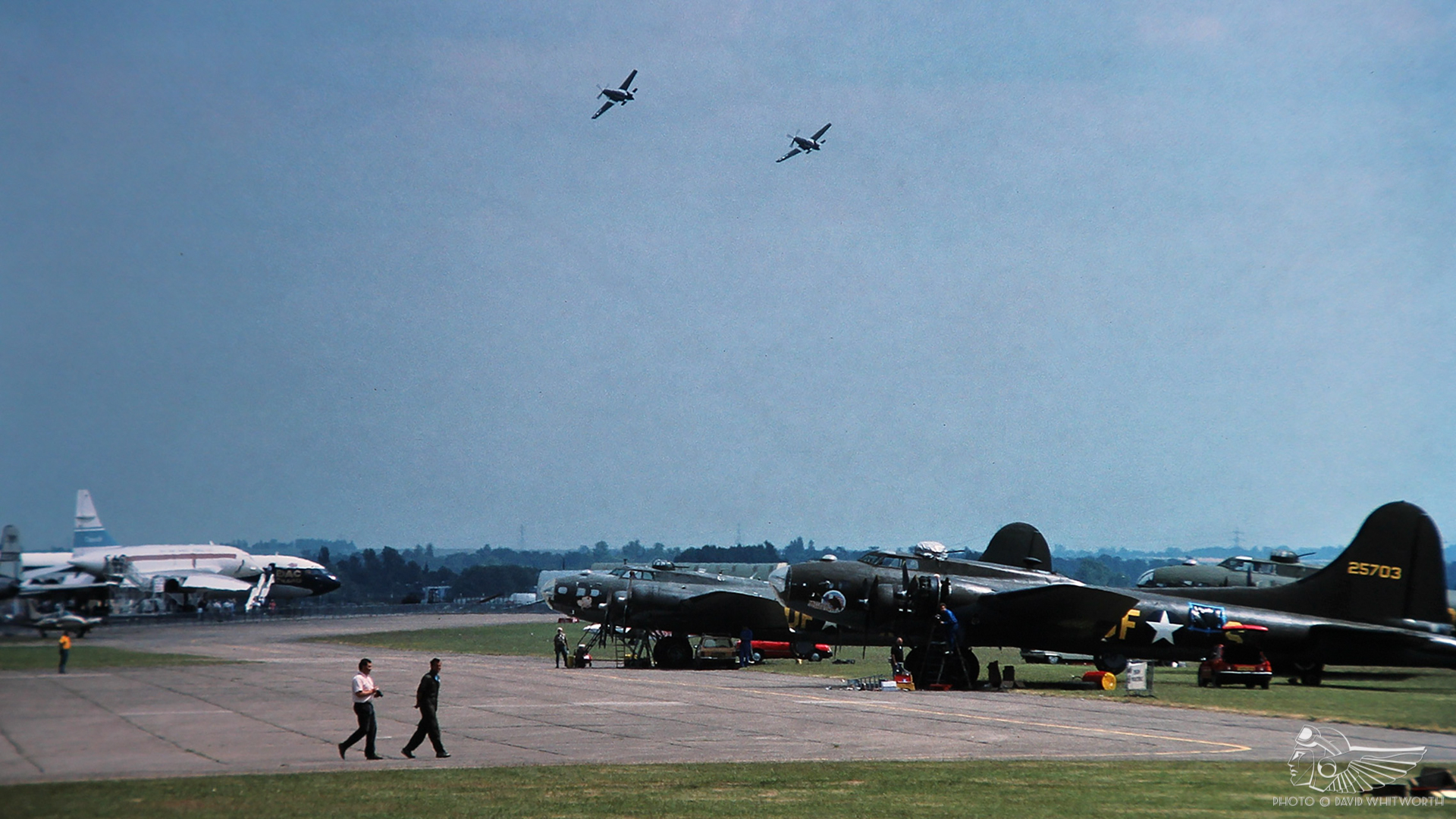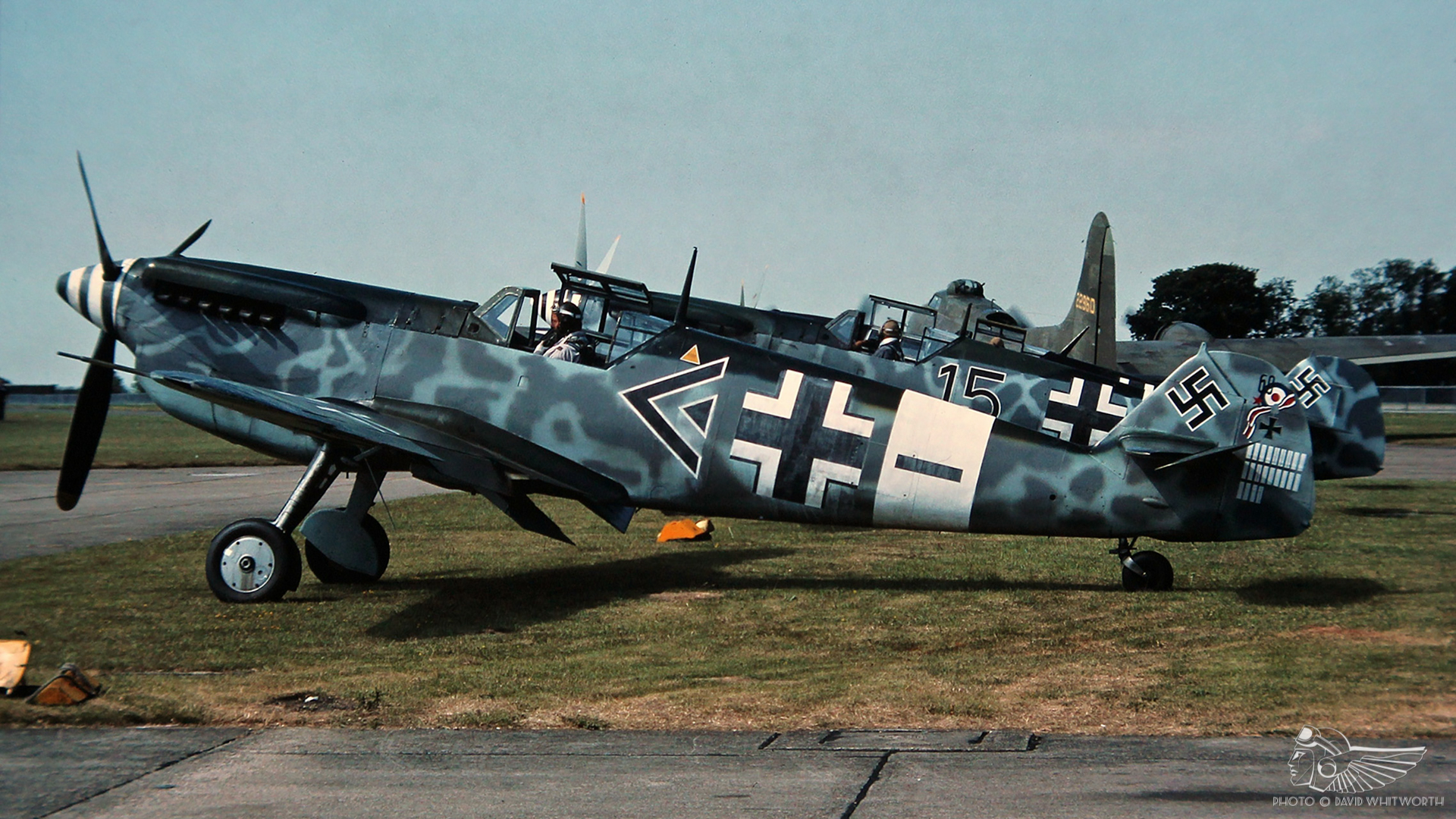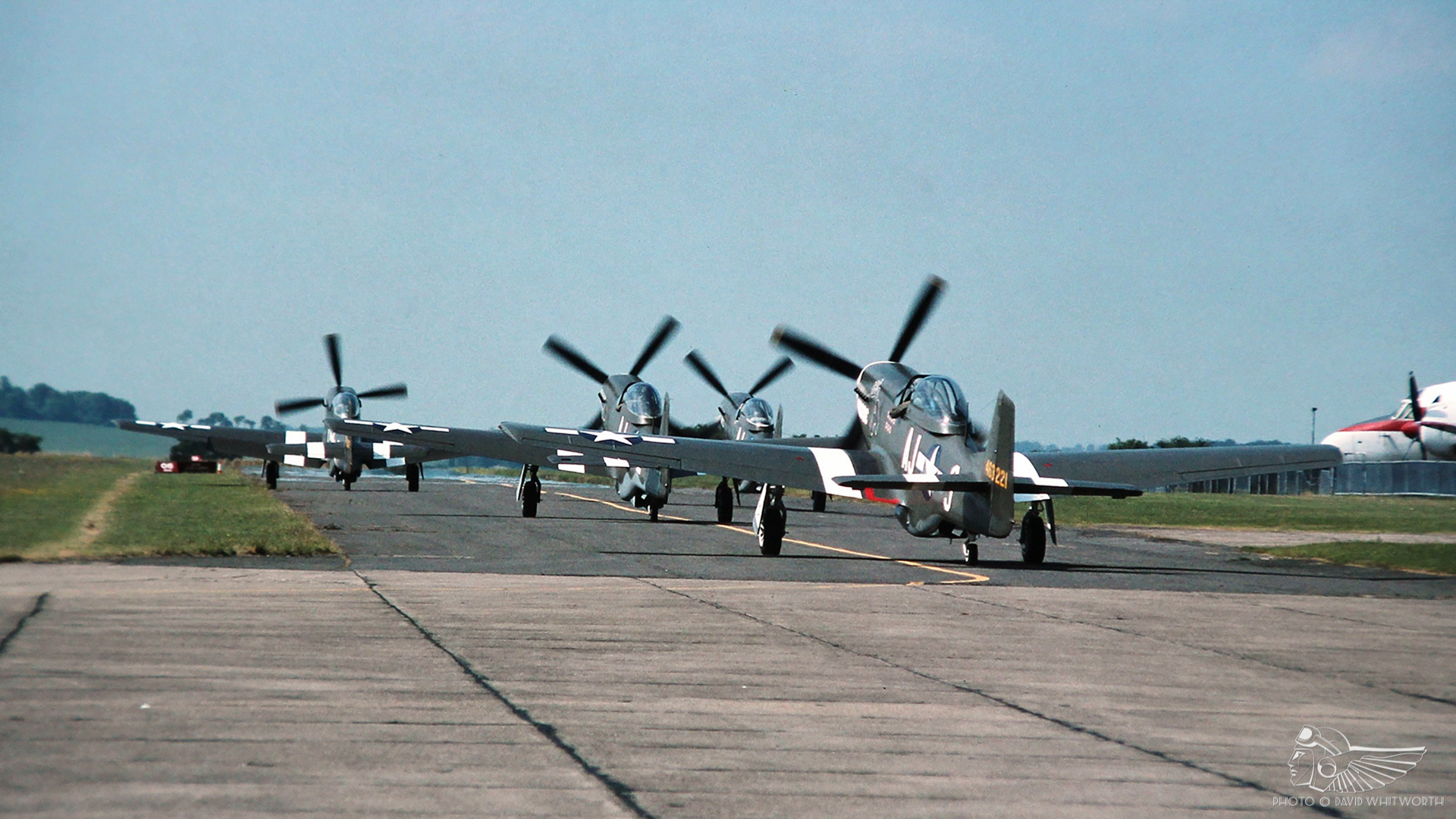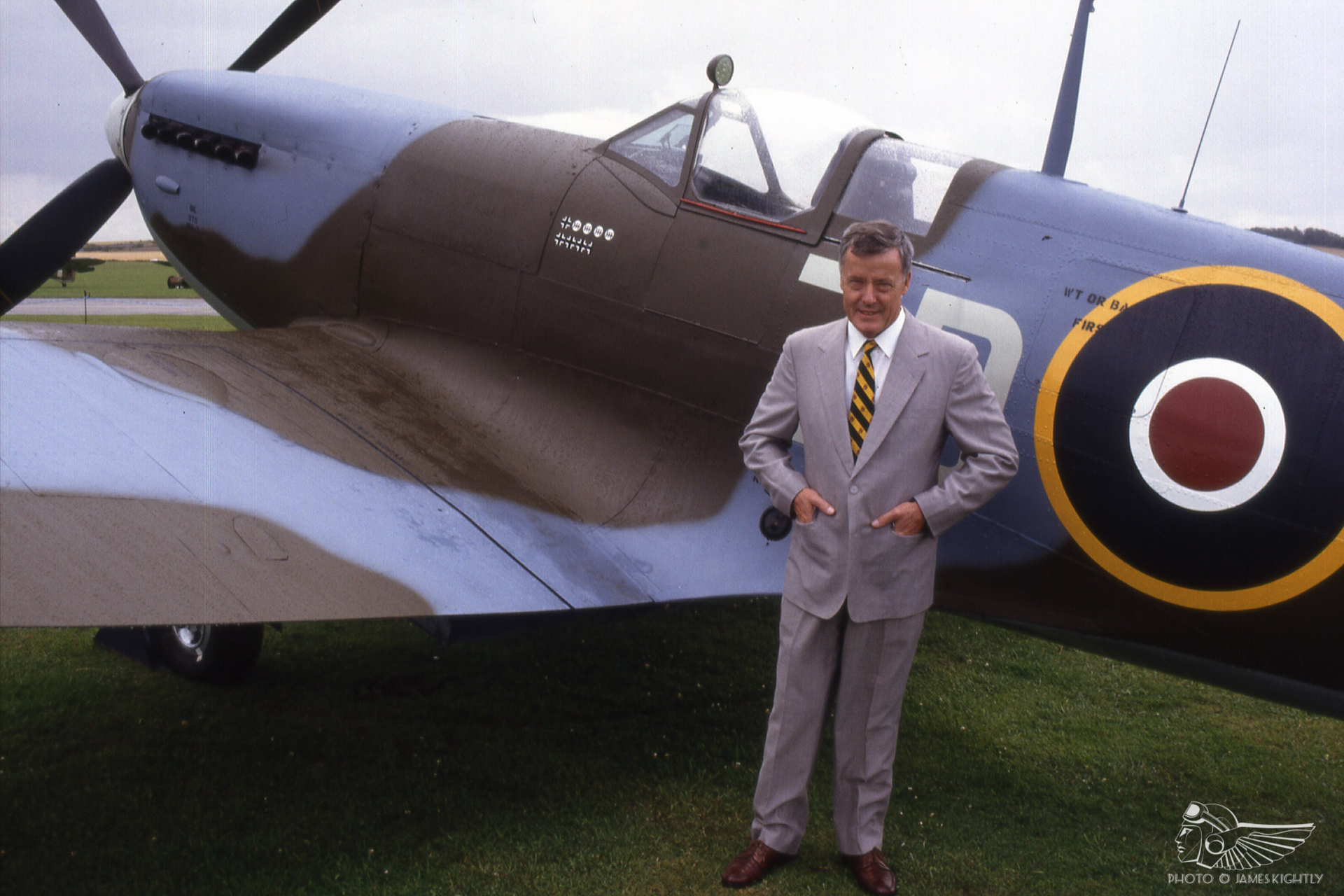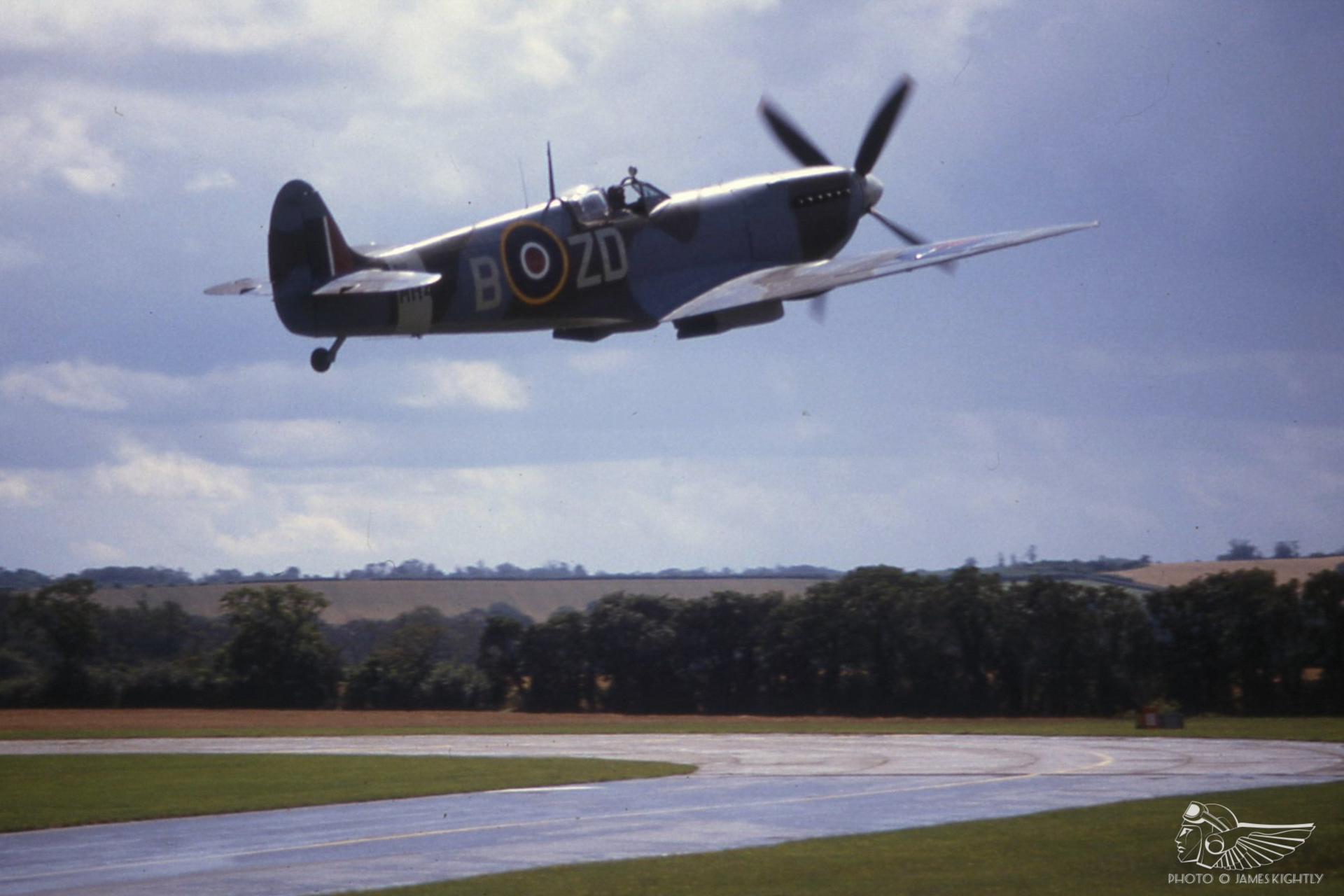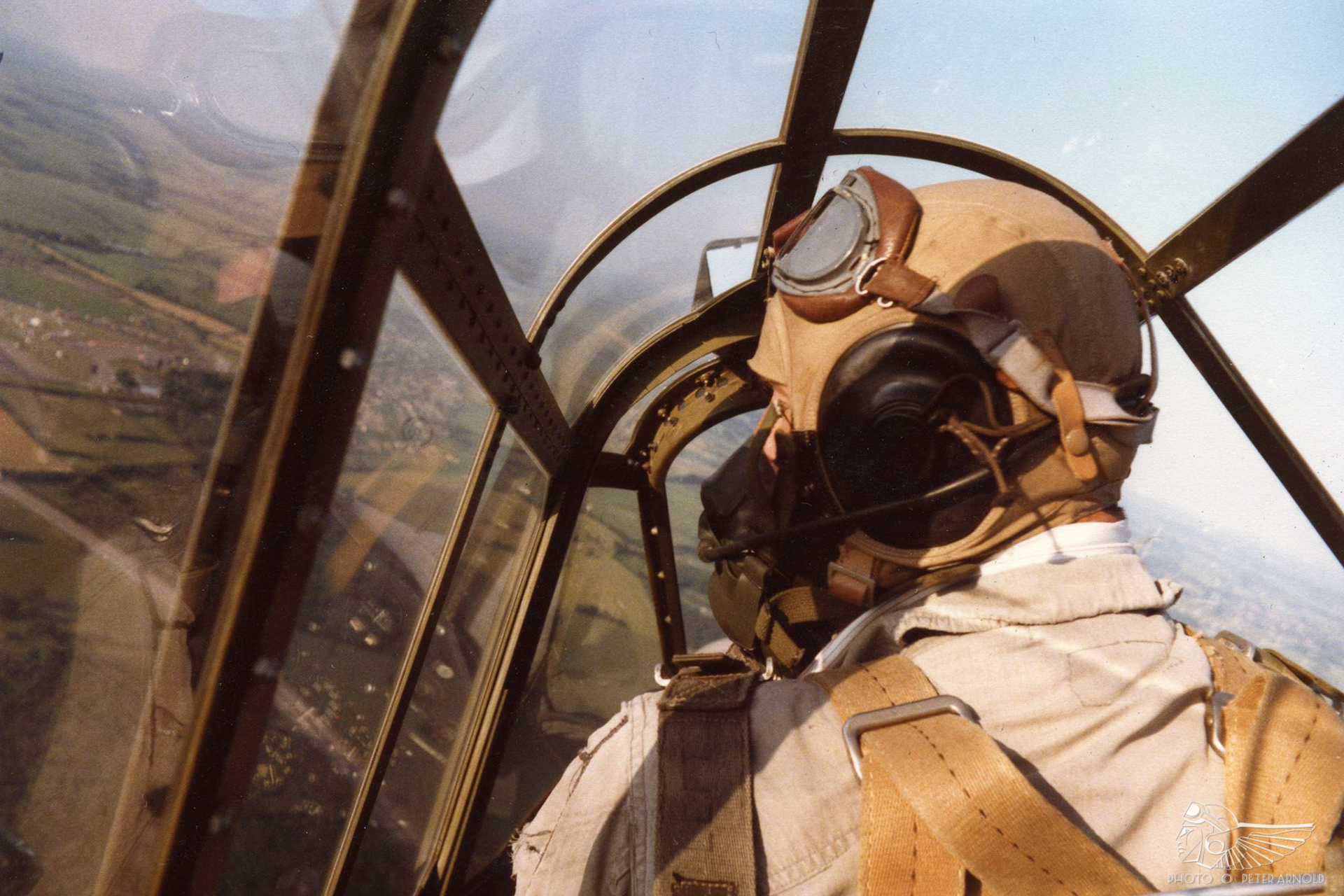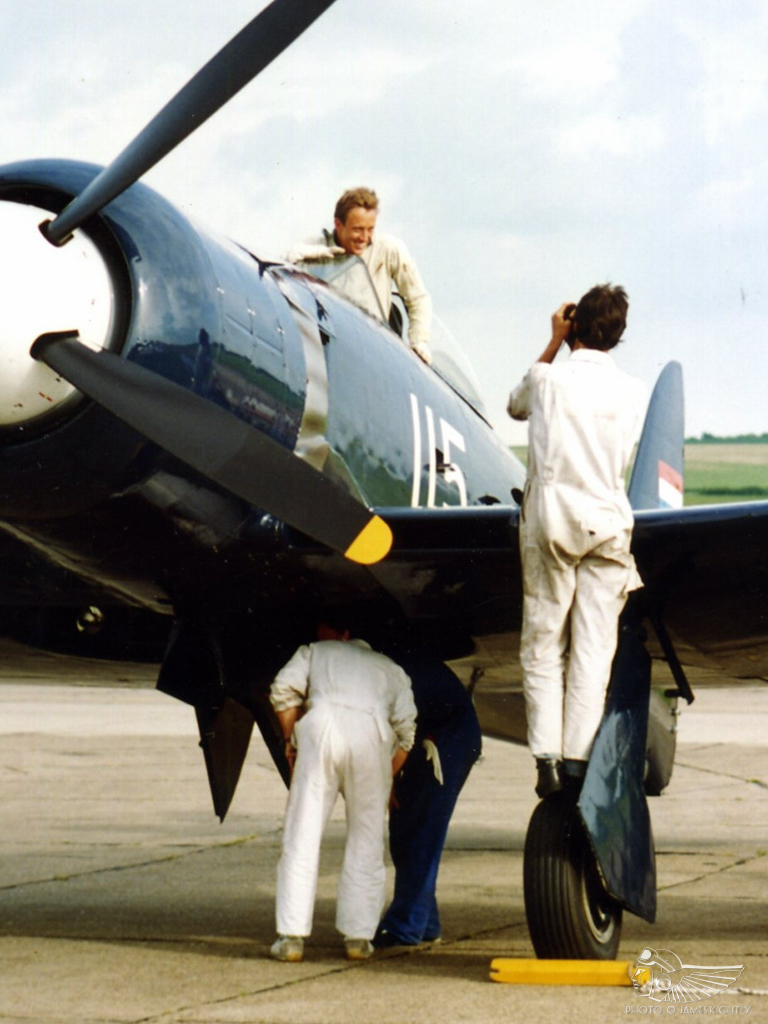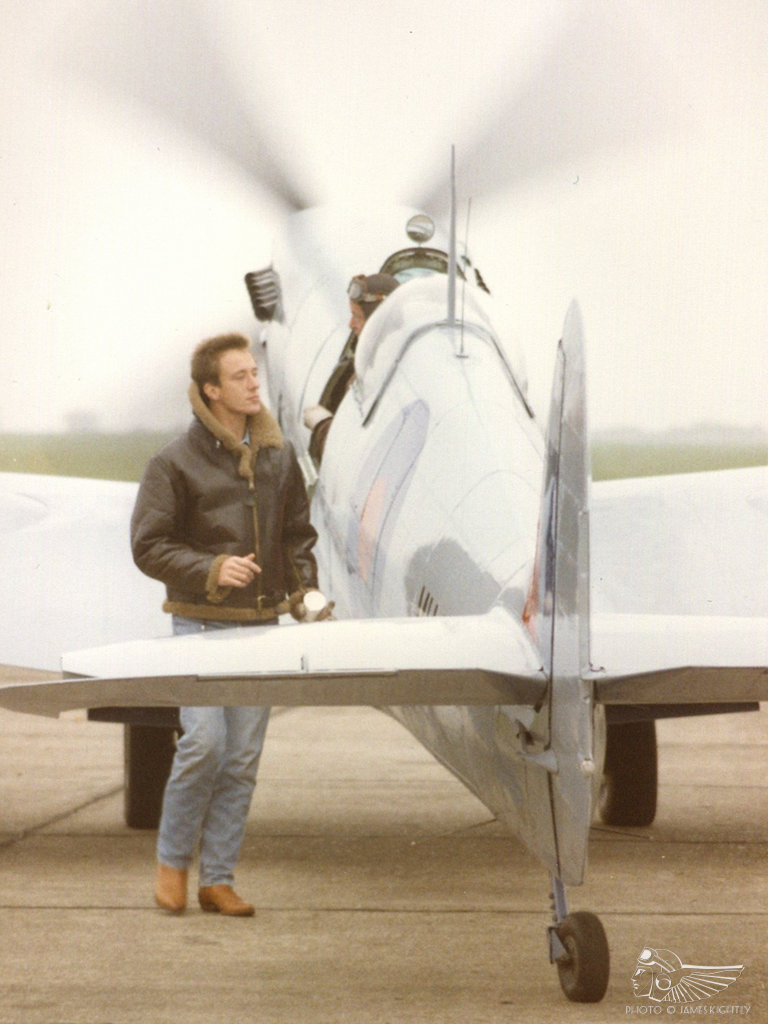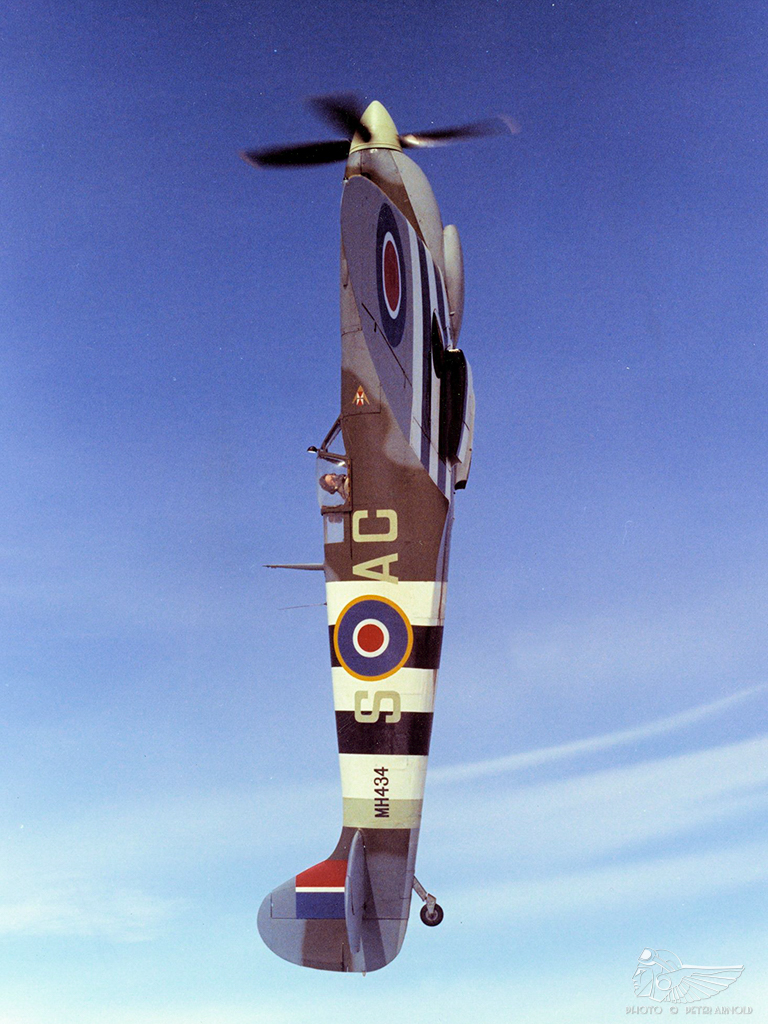The Old Flying Machine Company (OFMC) has been at the forefront of the European warbird industry since the early 1980s. Under the leadership of the internationally renowned and respected former leader of the Red Arrows, Ray Hanna, and his son, Mark, OFMC flourished into one of the leading operators of vintage aircraft from World Wars One and Two, and the Cold War era. OFMC’s superb collection appeared at events across the UK and Europe, always delivering displays of elegance, grace and panache in the true “Hanna spirit”.
Raynham Hanna was born on 28 August 1928 at Takapuna, New Zealand. At the age of 21, he travelled to the United Kingdom with the ambition of joining the Royal Air Force, in due course qualifying onto the last of the piston-engine fighters in service, including the Hawker Sea Fury, Hawker Tempest and Bristol Beaufighter. A posting to Germany with No 79 Squadron put Ray at the controls of the Gloster Meteor, flying low-level fighter reconnaissance sorties and formation aerobatic training with the unofficial motto, ‘Never above 100ft’. A posting to the Overseas Ferry Squadron followed, taking Ray as far afield as India and Pakistan, before he returned to England and reacquainted himself with the Meteor, this time as part of the College of Air Warfare’s aerobatic team. In 1965, he was selected to join the newly formed Red Arrows display team, which he led for four years to great critical acclaim, in the process inspiring thousands of youngsters to fly.
On 21 February 1970 Ray was given the opportunity to fly Spitfire LFIXb MH434 by its owner, Sir Adrian Swire, setting in motion events that would lead him to establish OFMC alongside his young son Mark over a decade later. After leaving the RAF, Ray joined the civilian ranks flying Boeing 707s for several years and continuing to fly MH434 in his unmistakable style.
OFMC’s UK operation started humbly in the early 1980s, with the ownership of a Max Holste Broussard and a share in a Swiss Pilatus P2 between the Hannas, Arthur Gibson and a friend of Mark’s, John Watts. At this point Ray Hanna and his associate Mal Rose had already bought, and had under restoration with the Hong Kong Aircraft Engineering Company (HAEC), a Commonwealth CA-18 Mustang. The P2’s purchase from Switzerland was to facilitate Mark’s eventual training on tail dragger ‘warbird’ types, giving him the necessary preparation to fly the high-performance Mustang in anticipation of its eventual arrival in the UK following completion of its rebuild by HAEC. At this stage, however, the idea was essentially just to fly for fun. There was little intention to develop into a more commercial, business-orientated operation in the long term, certainly not to the scale that OFMC would later blossom into. The real action point, in terms of a shift towards vintage aircraft operation, came with the purchase at auction of Spitfire MH434 on 14 April 1983 by Nalfire Aviation Limited, a company Ray Hanna was associated with.
Ted Inman, then Director of Imperial War Museum Duxford, approached Ray Hanna after the auction and proposed that he base MH434 at Duxford. Whilst not wholly-owned by Ray at the point it first came to Duxford, he and OFMC were for all intents and purposes left at their own devices to operate the aeroplane and much further down the line, OFMC discretely claimed ownership of the Spitfire. Ray Hanna was a recognised aviation name at this point, for both his Royal Air Force exploits leading the Red Arrows and also the impact he had been making on the British airshow circuit since the 1970s flying MH434, and having him base his Spitfire at Duxford, together with a smattering of other historic aeroplanes, could certainly have ignited the fuse on the historic aircraft restoration and preservation scene at Duxford, something Ted Inman may have appreciated at the time.
Furthermore, Duxford itself was a well-known former RAF station with a terrific history coursing through its veins dating back to 1918. It had seen the RAF – including No.19 Squadron, the first operational Spitfire unit – and US Army Air Force operate from its hallowed turf during the Second World War and had latterly played host to charismatic early jets like the Meteor and Javelin postwar. The airfield’s rich historical tapestry and surviving Belfast Truss hangars, one of which OFMC still occupies, made it the ideal location not only to operate an airworthy Spitfire from, but to develop a profile as a hub for historic aviation preservation and restoration, the likes of which couldn’t be found anywhere else in the UK.
A little over a year after Ray Hanna acquired MH434, OFMC began to gain momentum when he leased ‘Sneak Attack’, a stunning RAF desert camouflage Curtiss P-40E Kittyhawk Mk1A, from the USA, housing the aircraft at Duxford from June 1984 until 1989. This was a former Royal Canadian Air Force machine sold onto the civil register in 1942 before passing through a succession of private operators; Bob Warden, Neil Rose and George Perez each owned the aircraft for a time before it was bought by John R. Paul in 1966, who rebuilt the aircraft and operated it from Livermore, California, in 1970. Under Paul’s ownership, the Kittyhawk was painted in a desert scheme with traditional ‘shark mouth’ nose markings, bearing the fuselage codes SU-E as a tribute to his wife. It was in this guise that the Kittyhawk was leased to Ray in 1984, its distinctive markings making it a vivid and popular airshow performer. Warbird aficionados may be interested to know that this particular P-40E partook in the filming of Michael Bay’s 2001 blockbuster Pearl Harbour, alongside several other US-based Kittyhawks.
In February 1985, the CA-18 Mustang arrived at Gatwick Airport in the cargo hold of a Cathay Pacific Boeing 747 and shortly thereafter was reassembled and flown to Duxford to join its stablemates. This Commonwealth Aircraft Corporation-built P-51 was manufactured in 1951 and joined Royal Australian Air Force (RAAF) service in 1953. Following its retirement from military service, the aircraft passed through several owners before a landing accident halted its flying career in 1973. Recovered from Manila, the aircraft was acquired by Ray Hanna and Mal Rose in 1981, restored by HAEC and, after its arrival in the UK, placed on the British civil register as G-HAEC and painted initially in No. 3 Squadron RAAF camouflage.
With a hangar steadily filling with aeroplanes, the Hannas looked to place their business of owning and operating historic aircraft on a more commercial footing. Originally, it had all been about having a bit of fun with the Spitfire and Mustang, but with the Kittyhawk’s arrival it became clear that they would have to form a company, employing a full-time engineer – Roger Shepherd taking on the role as OFMC’s Chief Engineer from the outset – and steering their little organisation towards the world of airshow bookings, film and television work, and active restorations and trades in order to give the company a fair financial base on which to operate each year.
Duxford at OFMC’s inception in the 1980s was far removed from the mammoth aviation museum and vintage aviation Mecca that it is today. It could be argued that OFMC’s presence as a fledgling warbird organisation during the 1980s was a catalyst for the airfield’s rapid expansion in this area; things were more discrete at that time, with the Aircraft Restoration Company existing as a small engineering organisation (its presence far removed from the major restoration and maintenance facility it occupies today) and Lindsay Walton being a prominent name on the airshow circuit. Once the OFMC established a footing at Duxford with the Spitfire, Mustang and Kittyhawk in particular, Duxford began to burgeon.
OFMC and the Hannas also played an important part in bringing Stephen Grey, and consequently The Fighter Collection (TFC), to Duxford in the 1980s in a move of such historical magnitude insofar as the European warbird scene is concerned that it continues to define the warbird restoration and preservation movement in the second decade of the 21st century. During his tenure flying Stephen’s aeroplanes – namely the Mustang and Wildcat in the ’80s – there is every possibility that Ray had helped in some way to facilitate the relocation of TFC to Duxford.
In many ways, OFMC was responsible for part of the development of the scene as a whole. There were collectors and restorers such as Doug Arnold and Robs Lamplough who had become established names, but in terms of giving it a slightly different profile and perhaps a different kind of credibility, OFMC and Ray Hanna added a certain depth of polish, a gloss to what had typically been a very private, “closed doors” industry.
If Ray was the face of the OFMC during its fledgling years, Mark was the driving force behind the scenes. Born 6 August 1959, Mark was taught to fly by his father at the age of 16, flying a T-34 Mentor off a coral airfield in the Philippines. A career in the RAF followed naturally, Mark flying both the Hawker Hunter and McDonnell Douglas F-4 Phantom in service with Nos 111, 56 and 23 Squadrons, including a stint in the Falklands.
“Mark didn’t leave the RAF until 1988, although he had already begun running the Company on a more full-time basis in 1986-7″, explains Sarah Hanna, daughter of Ray, sister of Mark and OFMC’s Managing Director. “He’d taken Premature Voluntary Retirement (PVR) at a time where the RAF was going through a phase when an awful lot of guys were feeling a bit disheartened because they didn’t really want to fly the Tornado and so a lot of them were leaving to go to the airlines; Cathay Pacific, Swiss Air, off to wherever they could find work, where there was a decent salary. They were short of pilots then, they didn’t have to axe 200 of them because they couldn’t afford them. There was quite literally a brain drain of guys going away. To try and stop that, whenever any of the guys who were on longish commissions put in a PVR request, they would take them off flying and put them on simulators or whatever other duties they could so that by the time they left the Air Force, they’d been two or three years without flying. It was a stinking trick. Mark was put onto the Phantom simulator at RAF Wattisham and he had his own ‘phone installed at his office there to deal with airshow bookings and that sort of thing. Finally, in 1988 he was released and the Company really started to develop and grow and the whole business of trading and restoration really took off because Mark was so passionate about it.”
It was Mark who was ultimately responsible for steering OFMC into the business of airshows, film, aircraft trading and restorations; it was his passion and his manner that drove the company into new territory behind the scenes. “It goes without saying that father was incredibly important. My father was always passionate about it but he was based overseas during the earlier years, he didn’t have the time, he wasn’t allowed the time, there were only so many days he could come over here. It was really Mark who built all of this, who’s largely responsible for the history, the memories, the triumphs and all the aircraft at one stage or another passing through the Company. The way people were trying to make it happen and be commercial was a mix of airshows, restoration, trades, exchanges and so on. It was very difficult.
“When my brother was here, yes he was an incredibly good looking guy, yes people thought he’d had it all handed to him on a plate, but it’s absolute rubbish. He hadn’t. He really worked for this Company and without everything he achieved, we wouldn’t still be here”, Sarah continues. “My father was the shyest man imaginable. He was a man of few words but both he and Mark always had time for people and they would both happily talk to enthusiasts in the crowd. Mark was certainly more outgoing. He had oodles of charisma and charm, and if people were interested, he would gladly share his passion for aviation at any given opportunity.”
1988 was a busy year for OFMC, with the arrival of three key aircraft that would become airshow stalwarts during their time in the UK. Firstly, imported from the USA where it had been operated by Tom Friedkin and Cinema Air, was an F4U-4 Corsair that had appeared in troubled US drama Baa, Baa, Black Sheep in 1976-8. A further US Navy aircraft arrived in 1988 courtesy of a Grumman TBM Avenger, an altogether different type to the fighters that OFMC had to their name at that point. The Avenger had passed through a whole host of previous owners, including Hillcrest Aircraft, Paramount Leasing Corporation and Gro Pro Corporation before joining Merlin Aire Limited in Pennsylvania. The Avenger was operated on the UK airshow circuit from 1988 to 1992, at which point the aircraft was sold to Sir Tim Wallis’ Alpine Fighter Collection in Wanaka, New Zealand, along with a Tora! Tora! Tora! “Zero” (modified AT6 Texan) that had also been operated by OFMC during the late ’80s. It had also acted as a cameraship during the filming of Michael Caton-Jones’ Memphis Belle film in East Anglia during the Summer of 1989.
Another Memphis Belle alumnus was Hispano Aviación HA-1112 Buchón (G-BOML), the third of OFMC’s 1988 arrivals. The Buchón was one of 170 Merlin engine Bf-109s manufactured in Spain for service with the Ejército del Aire, serving in Spain, North Africa and the Canary Islands until the mid-1960s. As luck should have it, the Buchóns were in the midst of withdrawal from military service at the point where The Battle of Britain was in pre-production and Hamish Mahaddie bought 27 Buchóns for the film, 17 of which he returned to airworthy condition. OFMC’s Buchón was one of six machines maintained in taxying condition for the film, and it appeared in sequences filmed at Tablada Airfield in Spain (doubling as a German-occupied French airfield).
After shooting concluded, the aircraft was owned for a time by the Victory Air Museum in Illinois, USA, before being placed in storage and eventually sold to Gordon Plaskett, who began restoring the Buchón to flying condition. Plaskett sold the aircraft to UK collector Nick Grace, of Spitfire Mk.IXT ML407 fame, in late 1986 and Grace completed the restoration with the aircraft flying for the first time on 6 May 1988, a mere four days before it flew to Duxford to partake in the filming of television drama Piece of Cake, alongside Spitfire MH434 and others. Nick Grace was tragically killed in a car accident in October 1988 and OFMC thereafter purchased the Buchón, taking delivery of it shortly before Christmas that year. It went on to play a starring part in the production of Memphis Belle, where it flew alongside Hans Dittes’ Buchón and the ex-Charles Church machine playing the part of Messerschmitt Bf-109s, circa 1943. G-BOML continued to fly regularly with OFMC (barring a period between 1993 and 1997, after a wheels-up landing put it on the shelf for a time) until it was lost in the accident that claimed Mark Hanna’s life on 26 September 1999.
OFMC’s expansion continued the following year with the arrival of a Mikoyan-Gurevich MiG-21 Fishbed, which remained as a static exhibit throughout its tenure with the Company, and in 1990, the fabulous former Canadian Armed Forces Canadair CT-133 Silver Star (colloquially known as a T-33 Shooting Star), an example famously owned by Ormond Haydon-Baillie in the mid-‘70s and flown under the guise ‘Black Knight’. Haydon-Baillie had flown the T-33 from 1974 until his untimely death in a P-51D Mustang crash in Mainz, Germany on 3 July 1977. Following his death, the Shooting Star was sold by the Haydon-Baillie estate to Anvil Aviation, who continued to operate it in the UK before exporting it to the USA in 1985, where it passed through several owners before winding up in Switzerland in the late-‘80s and eventually falling under OFMC’s ownership at the start of the next decade. The aircraft was later sold to Golden Apple Operations Limited and lost in a non-fatal crash at Duxford in 2007.
At the opposite end of the aviation spectrum came the World War One types, with the likes of the distinctive Ranger engine Fokker D.VII (flown by Franco Actis in Switzerland, now owned by Jerry Yagen at Virginia Beach), adorned in an all-black paint scheme with distinctive skull and crossbones on the fuselage, coming to Hangar 3 for a limited time during the late 1980s. Whilst somewhat atypical compared to the big piston fighters and classic jets one came to associate with OFMC at its peak, the variety of aeroplanes you could find under OFMC’s was one of the real historic aviation pleasures of the 1980s and 1990s. Turning up at Duxford, heading, always, to Hangars 2 and 3 first to see what had changed (in the pre-internet days, you might read some news in the magazines but there was always something new to marvel at), it was all too easy for a young enthusiast to lose himself in what appeared to an outsider’s perspective to be pure aviation grandeur, all overseen by the towering personalities of Ray and Mark Hanna.
The first few years of OFMC’s operation in the mid to late-1980s set the tone for what would follow in the subsequent decade – a bustling hangar full of aeroplanes, be they fliers, leases, trades or restorations, with Ray and Mark firmly establishing their operation as one of Europe’s premier purveyors of vintage aeroplanes. Their airshow flying quickly became legendary. It’s difficult to articulate exactly why, but you felt like you knew the Hannas when you watched them fly. Their warbird flying was characterful, in some incredibly special way; Ray’s masterful control and experience contrasting with Mark’s more aggressive youthful exuberance. Both would demonstrate facets of the other’s style – Ray, even in his 70s, flew with the grand flamboyance of a young soul still yearning for the burning blue, whilst Mark could scintillate with the élan of an aviator twice his senior.
The spirit of the Hannas lives on in those who were inspired to follow in their footsteps – the aviators, the engineers, the enthusiasts – and their contributions to aviation will echo for generations hence.


